Interpretation through Style Analysis1
From the historian's point of view, a composer writes his music in the context of a style. This means that the resources available to him and his contemporaries comprise a normative language, a common domain of materials, techniques, and conventions from which unique compositions may be formed. In order to portray a style, the historian must put together a composite picture, a compilation of traits observed in individual pieces of music. Since the investigation of style proceeds from individual works to a generalized conception, its method of analysis must be able to probe the basic elements of a composition (including acoustical resources, harmony, melody, and rhythm) and to determine the characteristic ways in which these elements interact to create movement and communicate a sense of coherent musical shape.2 A method of style analysis is indispensable for measuring progress or change, or for identifying historically distinctive traits of a school, a composer, or a particular composition. And since the procedures of style analysis involve the examination of all elements that control the design of individual works, they may apply to criticism and interpretation as well as to historical issues of style.3
Whether performing, teaching, listening attentively, or undertaking a critical analysis, we are occupied with interpreting the musical surface of a composition, the succession of notes on the page. If the events of the surface are to be comprehensible, we must be able to relate them to a controlling organization. Without some notion of the grouping, function, or interrelationship of details, the interpreter is at a loss. It was this central issue of interpretation that Heinrich Schenker addressed in depicting the plight of a student or performer who would concern himself solely with the musical "present," or surface. "Every change of sound and of figuration, every chromatic shift, every neighbor note signifies something new to him. Each novelty leads him further away from the coherence which derives from the background."4
The first movement of Mozart's String Quartet in D minor, K. 421 (see Appendix), illustrates the interpreter's quandary, for in several notable passages, the progression from one event to the next is disjunct and discontinuous, interrupted by contrasts apparently unmotivated by the immediate context of the surface. In m. 14, for example, what justifies the appearance of an unconnected B-flat2 in the first violin? How can we explain the accent it receives, or the sudden shift of register and drop to piano that follows? Instinctively, the interpreter may sense underlying coherence and tightness of control, yet these qualities are scarcely apparent in the discontinuities that characterize the surface. They become evident only when we discover how the surface events relate to one another and to the features of a larger organization.5 In stylistic terms, the events of m. 14 constitute an interaction of change in dynamics, timbre, chord function, linear continuity, and rhythmic patterning. By interpreting such events in terms of musical elements and their combined effect, style analysis can help us to appreciate their function as part of larger designs. This process of analysis enables us to grasp the integration of an event within a larger scheme and to identify its particular contribution to the synthesis of the whole.
In applying style analysis to the work in question, we may begin by probing the unity of substance of the piece, the characterizing gestures and patterns that lend a general sense of relatedness to events within the movement. Most conspicuous among these sources of unity are the recurrent motives, such as the nearly ubiquitous octave leaps and dotted rhythms first introduced in the opening measures. Other consistencies involve materials whose family resemblances are less specific. The passing of motivic fragments from one part to another, for instance, becomes a characteristic source of activity, lending animation to transitional and developmental passages throughout (see mm. 12-14, 19-20, 66-69). Upbeat figures, so prominent in the inner-voice accompaniment to the opening theme, likewise assume an almost thematic role as ever-present sources of movement. Additional features that appear early and then permeate the fabric thereafter include falling melodic gestures, prominent appoggiaturas, and chromatic inflections. Especially noteworthy is the Neapolitan relationship, implied at several points by the cellist's line (E, E-flat, D in mm. 14-15; F, E-flat, D in m. 32), further emphasized by the establishment of E-flat as a temporary center (mm. 42-45), and finally manifested in the harmonic progression of mm. 97 and 114.6
Awareness of unifying gestures and patterns helps us to determine the basic materials from which relationships are likely to emerge, but such a unity of substance does not in itself explain how surface events work as part of a coherent whole. In our pursuit of interpretation, we must deal not only with the relatedness of materials but with the multiple levels of structure through which the relationships are perceived. As the movement unfolds, motives form phrases, the phrases group flexibly into larger sentences and themes, and the grouping of themes and transition passages forms the main sections that give the piece its overall shape. Different levels interlock, interpenetrate, and overlap in the ineluctable flow of the music. One level shades into another, especially in the realm of motive, phrase, and sentence (see mm. 14-24, for instance). Yet some sort of distinction between levels must be drawn if our analysis is to succeed in reflecting the hierarchic order on which the coherence of the work must depend.7
Our main concern is with the music as movement, yet we must remind ourselves that musical movement is a multi-level phenomenon. Foreground events perceived as movement form shapes, such as subphrases or phrases, in our memory. These smaller shapes, perceived in retrospect as rhythmic units, generate movement on higher levels of structure.8 To represent this hierarchic nature of movement, an analytical framework may be constructed that makes flexible distinctions among three dimensions of activity: large, middle, and small.9 The large dimension concerns overall shape and the elements of long-range continuity that enable us to perceive the whole as an entity rather than a juxtaposition of sections. Analysis in middle dimensions involves a change of perspective to sources of coherence within main sections (e.g. exposition, development, and recapitulation). In the small dimension, our focus shifts to the events of the foreground, the sources of movement and shape within phrases, themes, and transition passages that comprise the main sections.
In the discussion that follows, the division of observations into three dimensions serves as a basis for the analysis of interacting elements and their contribution to movement and shape. No attempt will be made to fill in this framework with any degree of completeness, for our purpose is not to offer a comprehensive analysis, but simply to illustrate, through a sampling of references to the music, how a style-analytical method may apply usefully to the interpretation of an individual work.
Large dimension
In accordance with grammatical norms of late eighteenth-century music, the opening allegro moderato of the D-minor quartet acts as a vehicle for large-scale tonal movement. The symmetrical sonata form articulates the progress from tonic to relative major in the exposition, leads the music from a more remote relationship, E-flat, back to tonic in the development section, and confirms the return to tonic stability in the course of the recapitulation. The analysis of elements and interactions that yield this overall design must identify sources of activity that motivate the tonal scheme as well as sources of structural stability that reinforce the controlling sonata form.
The stability on which the form depends requires that the main divisions (exposition, development, and recapitulation) be clearly punctuated; yet characteristically, the connections between these sections permit an ongoing movement that subsumes them within a larger continuity. The sense of continuity is especially telling in the link between exposition and development. In the latter part of the exposition (mm. 32-40), a series of cadences serves to announce the imminent close of the section. The interaction of various elements, however, lends mobility even as the cadential punctuations signal closure. Most notable among these sources of mobility is the device of metrical displacement. The punctuating cadences in mm. 32, 35, 37, and 39 have been designed to fall in the middle of the measure instead of on the downbeat, so that a conflict arises between metrical stress and cadential emphasis.10 The displaced cadences, which occur throughout the exposition, offer a potential source of mobility that is realized in various ways. In the middle of m. 32, for instance, the displacement provides an appropriately unstable setting for the inflection, syncopation, and sforzando by which an open phrase connection takes place. In m. 35, a likewise open, displaced cadence initiates the triplet sixteenth-note movement that continues from here to the last beat of m. 39. Moreover, the texture lightens to three voices at this point, and the dynamic level remains a uniform piano from here to the end of the section. Working in concert, these elements modify the impact of cadential punctuation and promote a sense of open-ended movement as the exposition comes to a close.
In this context of mobility, the repeating, half-measure cadence formula of mm. 39-40 acquires a double meaning. To be sure, the repeating cadences lend emphasis to the process of closure, but the insistent, rising triplet figure in the first violin, growing out of the previous triplet accompaniment, prevents the cadences from stabilizing. Instead, their open-ended quality causes them to act collectively as a large-scale upbeat, a function confirmed by the development of the pattern that immediately follows in the two endings: a crescendo replaces the previously sustained piano, and the figure becomes harmonically directed, leading to the return or to the start of the development. As a result of this large-scale upbeat effect, a sense of continuity persists, transcending the division between sections and helping to animate the process of tonal movement.11
Interpreted from the standpoint of contributing elements, the large-scale movement becomes a palpable force binding the sections together and lending cohesion to the whole. Thus established, an interpretation of the large-dimension scheme provides a basis for the study of interactions in middle and small dimensions.
Middle dimension
When viewed from the vantage point of the structure and continuity of the whole, each of the principal sections contributes to an overall plan of tonal movement. Examined at closer range, each section forms a coherent shape in its own right. The exposition, for example, may be interpreted on this level as a balanced, two-part design incorporating movement from tonic to relative major. After an opening eight-measure sentence establishes the tonic key, the process of transition dominates the following sixteen measures (9-24). The relative major having been reached by m. 24, the exposition concludes with a comparable span, sixteen measures of stable thematic statement in the new key (mm. 25-40). Analysis of elements that interact within this plan reveals ways in which surface details work to animate the transition, promote stabilization of the relative major, and enhance the overall coherence of the section.
As the exposition progresses, various elements that generate motion relate closely to the unfolding of the harmonic scheme, causing quality and source of movement to change precisely in accordance with successive stages of tonal transition. The process begins with the coordinated changes that take place from m. 9 on. After the stable, opening statement, ending in m. 8, the next four measures stand poised on the dominant (mm. 9-12). Here the phrasing underscores the mobility of the dominant harmony, for in the context of regular phrasing established at the outset, the change to shorter, repeating units sounds like an anacrusis, anticipating eventual resolution to a rhythmically stable, regular phrase.12 Perceived in this light, other sources of change and movement appear to have a united purpose in enhancing the combined mobility of harmony and phrasing. The contrast in dynamics of mm. 9 and 11, for example, works together with the shifts of register to articulate the fragmentation of phrasing, and this enhances the effect of an acceleration in phrase rhythm.13 The driving eighth-note pulse of the cello contributes an increase in motion over the halting upbeat accompaniment of mm. 5-6, and the inner parts become more active both rhythmically and melodically. Tension and movement are further increased by the part exchange in m. 11, where the descending line played by the second violin in m. 9 reappears an octave higher in the first.
The sense of anacrusis conveyed by mm. 9-12 leads us to expect resolution to something harmonically and rhythmically stable; but instead of resolving, the quality of urgent, directional motion now intensifies. The sixteenth-note figure of m. 10 reappears in m. 12, becoming a two-beat motive that winds down through the registers as continuation of the large-scale upbeat. The figure, which emerges as an embellishment of the repeating A in the cello (mm. 9 and 11), intensifies movement, not only by accelerating the surface rhythm from eighths to sixteenths but also by producing a quickened rate of change in timbre, register, and dynamics.
The process of transition reaches a climax in the middle of m. 14. The repeating sixteenth-note figure has spent itself on reaching the lowest octave (first half of m. 14). The upbeat thus prolonged demands an emphatic, resolving accent; and now the appearance of a sustained chord, sounded forte in all parts, provides the anticipated rhythmic and dynamic consequence. In other respects, however, this chord (V of III) scarcely furnishes the stabilizing outcome demanded by the long dominant upbeat. Harmonically, the chord announces movement to the relative major by presenting a new dominant, and the dynamic accent it receives underscores the urgency with which this chord impels the music toward a new goal. Melodically, it introduces new sources of tension by the exposed placement of the seventh (B-flat2) and the leading tone (E2) in the outer voices. The B-flat2 in the first violin (which may be heard as an upper neighbor to the A2 in m. 12) calls for eventual downward resolution, and the E2 in the cello begs correspondingly for upward resolution to F2.14 Moreover, the placement of the
of III) scarcely furnishes the stabilizing outcome demanded by the long dominant upbeat. Harmonically, the chord announces movement to the relative major by presenting a new dominant, and the dynamic accent it receives underscores the urgency with which this chord impels the music toward a new goal. Melodically, it introduces new sources of tension by the exposed placement of the seventh (B-flat2) and the leading tone (E2) in the outer voices. The B-flat2 in the first violin (which may be heard as an upper neighbor to the A2 in m. 12) calls for eventual downward resolution, and the E2 in the cello begs correspondingly for upward resolution to F2.14 Moreover, the placement of the  chord in the middle of the measure (a displaced downbeat, in effect) serves to accentuate the conflict between accent and metrical stress already suggested by the displaced phrase and subphrase endings in mm. 8, 10, and 12. Now the displacement in m. 14 adds yet another source of tension and unresolved movement in the midst of tonal transition.
chord in the middle of the measure (a displaced downbeat, in effect) serves to accentuate the conflict between accent and metrical stress already suggested by the displaced phrase and subphrase endings in mm. 8, 10, and 12. Now the displacement in m. 14 adds yet another source of tension and unresolved movement in the midst of tonal transition.
In terms of contributing elements, then, the  chord acts as a pivot. Here the harmonic tension and rhythmic animation of the foregoing measures translates instantly to new sources of ongoing motion, so that the forward thrust initiated in tonic (mm. 9-14) continues without a break as gradual movement into the orbit of the relative major. The completion of transition, from m. 14 to 24, now unfolds as a consequence of this coordinated change in source of activity.
chord acts as a pivot. Here the harmonic tension and rhythmic animation of the foregoing measures translates instantly to new sources of ongoing motion, so that the forward thrust initiated in tonic (mm. 9-14) continues without a break as gradual movement into the orbit of the relative major. The completion of transition, from m. 14 to 24, now unfolds as a consequence of this coordinated change in source of activity.
The process begins with the contrast established between the  chord and the eighth-note upbeat to m. 15. The yawning melodic gaps that open in treble and bass line demand to be filled,15 the drop to piano anticipates dynamic increase, and the instability of the displaced downbeat in m. 14, intensified now by the sudden drop in dynamic level, calls for eventual return to regularized patterning. In response to the shift in register of m. 14, the line rises steadily from m. 15 on. And as the melodic ascent gradually fills the gap, its progress coincides with a step-by-step coalescing of phrasing that reverses the process of fragmentation in mm. 9-14. A pair of staccato eighths on the downbeat (first violin) resolves to a slur on beat 3; taken together, these miniature units (½ + ½) resolve rhythmically to the more continuous legato of m. 16, which constitutes a relatively stable, one-measure unit. The process continues as the collective mobility of mm. 15 and 16 forms an antecedent to a concrete two-measure unit (mm. 17-18). In the course of these four measures, which form a coalescing phrase pattern of ½ + ½ + 1 + 2, a growing stability of harmony underlies the expanding pattern of phrasing and upward progress of the melodic line. In m. 15, beat 3, for instance, the
chord and the eighth-note upbeat to m. 15. The yawning melodic gaps that open in treble and bass line demand to be filled,15 the drop to piano anticipates dynamic increase, and the instability of the displaced downbeat in m. 14, intensified now by the sudden drop in dynamic level, calls for eventual return to regularized patterning. In response to the shift in register of m. 14, the line rises steadily from m. 15 on. And as the melodic ascent gradually fills the gap, its progress coincides with a step-by-step coalescing of phrasing that reverses the process of fragmentation in mm. 9-14. A pair of staccato eighths on the downbeat (first violin) resolves to a slur on beat 3; taken together, these miniature units (½ + ½) resolve rhythmically to the more continuous legato of m. 16, which constitutes a relatively stable, one-measure unit. The process continues as the collective mobility of mm. 15 and 16 forms an antecedent to a concrete two-measure unit (mm. 17-18). In the course of these four measures, which form a coalescing phrase pattern of ½ + ½ + 1 + 2, a growing stability of harmony underlies the expanding pattern of phrasing and upward progress of the melodic line. In m. 15, beat 3, for instance, the  position of beat 1 resolves to a more stable
position of beat 1 resolves to a more stable  (V6 of IV in terms of the emerging relative major); reinforced now by a crescendo, the two-measure unit of mm. 17-18 comes still closer to the harmonic goal by reaching a root position dominant in a clearly articulated half cadence.
(V6 of IV in terms of the emerging relative major); reinforced now by a crescendo, the two-measure unit of mm. 17-18 comes still closer to the harmonic goal by reaching a root position dominant in a clearly articulated half cadence.
The next two measures (19-20) prolong the half cadence; and here, the dominant harmony that had been a temporary goal in m. 18 becomes a springboard. Animated by fragmented texture and increased activity of surface rhythm and line, these measures act as an anacrusis to mm. 21-24, a stabilizing four-measure phrase in which closure in the new key is finally achieved. Here, at last, the divergent strands of transition are tied together. As the dynamic level rises to forte (mm. 21-23), the line completes its gradual rise through F2 (first violin, m. 21) and G2 (second violin, m. 22) to A2 on the third beat of m. 23, thereby resolving the B-flat2 of m. 14 and closing the wide melodic gap opened on the upbeat to m. 15. The E2 of m. 14, whose resolution is foreshadowed an octave higher in m. 23, finally resolves in the proper register as the cadence falls in m. 24.16
As the exposition continues in the now stabilized relative major, a new quality of movement arises. A fast and relatively even rate of surface activity supports the balanced phrases of a secondary theme (mm. 25-32), phrase rhythm and rate of harmonic change become regular, and a consistent texture prevails. This new kind of activity emerges as a consolidation of the varied and changeable movement of the transition. Fragmentation, contrast, and a succession of upbeat patterns have motivated the progression from tonic to relative major, and here the stabilized relationships of the secondary theme form a balancing response. The faster, more homogeneous surface rhythm that accompanies the change emerges as a necessary consequence of stabilization. It provides a new kind of energy to sustain momentum as the exposition nears conclusion. By virtue of this coordinated change in source of activity, the second half of the exposition connects integrally to the first. Ongoing movement persists through tonal stabilization, contrast, and change in pattern.
Small dimension
Analysis on this level concerns sources of movement that form the smallest shapes by which the music is articulated (i.e. motive, subphrase, phrase, and sentence). Whereas the inspection of small details in large and middle dimensions has been concerned solely with their contribution to a larger process, our attention now turns to the detail in the context of its immediate surroundings. For example, elements involved in the last four measures of the transition (mm. 21-24) may be understood in the small dimension as sources of movement working to form a cohesive phrase. Here, a pattern of imitative entries, beginning with the cello on the upbeat to m. 21, lends homogeneity and provides continuity of movement. Rhythmically, each entry forms a half-measure unit, and collectively, an ascending series of four entries, starting with the cello in the second half of m. 21, conveys the effect of a large upbeat to the middle of m. 23—a reversal, in a sense, of the pattern of mm. 12-14. As a result of this anacrusis, the middle of m. 23 stands out as another displaced downbeat, this time embedded, however, within a larger unit of structure. Elements that lend continuity through this interior punctuation, incorporating it within the overall sweep of a four-measure phrase, include matters of line, dynamics, rhythm, and harmony. The melodic line begins to fall before beat 3 and continues its descent as the displaced accent occurs, the drop in dynamic level lessens the strength of the accent, and the acceleration in rate of chord change, from half and whole note to quarter, promotes ongoing movement. The animation conveyed by a faster harmonic rhythm, enhanced by the increased melodic activity of the first violin, becomes a headlong drive to the cadence in m. 24, where the harmonic rhythm accelerates from quarter note to eighth. Working together, these elements transform the upbeat energy of mm. 21-23 into a quality of directional movement to the conclusion of the phrase in m. 24.
The probing of relationships in the small dimension leads to a final step toward interpretation through style analysis: the discovery of connections between this small-scale order and the controlling features of middle and large dimensions. The displaced downbeat in m. 23, for instance, stands out as a strategic point of emphasis within the phrase, but the emphasis that falls on this beat also reinforces the sense of a middle-dimension, linear connection between the B-flat2 of m. 14 and the resolving A2 sounded here in the first violin. As we have seen, this sense of a linear connection is essential to the coherence of the passage. It justifies the disruption of m. 14 and provides a framework for the process of gradual coalescing that intervenes. Now since the mid-bar emphasis in m. 23 functions both as a controlling feature of the phrase (mm. 21-24) and of the middle-dimension process of transition, it establishes an integral relationship between the punctuating phrase and the larger plan to which it belongs.
A connection may likewise be drawn between this punctuating phrase and the overall continuity of movement—the phenomenon of an essentially uninterrupted motion that helps insure the coherence of the whole. We have seen that the faster surface rhythm from m. 25 on plays a middle-dimension role by contributing to the balanced profile of the exposition, and it also bears large-dimension significance by helping to motivate the tonal scheme. Now, we find that by virtue of the controlling plan of acceleration in mm. 21-24, this rhythmic increase is a continuation of the small-dimension design. To recapitulate, the prevailing half-note unit of activity of mm. 21-23 gives way to an impression of quarter-note movement in the second half of m. 23, where the lower parts clearly articulate a faster rate of chord change. Rate of activity quickens to eighths in m. 24, where surface rhythm and rate of chord change converge in the lower three parts, to be joined by the first violin on beat 2. Harmonic rhythm stabilizes as the cadence falls on beat 3, but now the rate of surface activity accelerates from eighths to sixteenths. The upbeat to the new theme thus emerges as another step in a continuous pattern of acceleration.17 The following diagram summarizes these relationships:

As revealed by this sample analysis, events within the phrase have significance on multiple levels. Interacting elements contribute to a small-dimension coherence, and at the same time they participate in larger processes of which the phrase forms an integral part. An observed detail, such as a change in dynamics and rhythmic movement in the middle of m. 23, belongs to a large-scale plan as well as to the immediate context of the phrase and the middle-dimension process of transition. Thus we arrive at an interpretation of the detail by explaining its function in terms of elements that interact simultaneously in different dimensions of organization.
It is a truism that our interpretation will reflect the nature of the questions we ask of the music. Different interpretations will reflect divergent points of view from which the music is inspected, and one view need not invalidate others. Yet in posing our questions, through one system of analysis or another, we must strive for clearly defined goals and for significant observations that will help us to achieve them.
As a basis for interpretation, style analysis claims pertinence by representing musical elements in motion and offering a framework for explaining how they function. Proceeding from individual elements, the method shows how directional movement may emerge from the interaction of mutually reinforcing sources of activity; and it reveals ways in which one kind of activity may supplant another, so that continuity on various levels persists in spite of contrast. The emphasis on motion is significant. As a composition is heard, it may indeed form a tangible, hierarchic design in our memory, but the impulses from which it grows are kinetic and dynamic in origin.18 Only as we retain them as shapes in our memory do they generate the building blocks of a musical architecture. This distinction between movement and shape in large, middle, and small dimensions provides us with a consistent procedure for relating a measure-by-measure succession of details to a larger scheme. Applied to an individual work, such an approach aims to identify the controlling sources of movement by which the foreground events relate coherently to background structure.
In conclusion, it may be noted that as we strive for a convincing interpretation through style analysis, we need not attempt to discover the composer's true intentions. Indeed, the composer's intentions may be ultimately inaccessible to analysis.19 The authority of an interpretation is strengthened, however, if it can be placed within the context of norms and conventions familiar to performers and listeners of the time when the music was written. Since the procedures of style analysis involve the isolation of composer's resources and the examination of their potential functions, the method readily enables us to relate our analysis of an individual work to larger issues of style. What position does the work occupy within the composer's oeuvre? Does it betray the influence of another composer or a foreign idiom? How does it heed the common assumptions of its contemporary audience? Such questions are significant to interpretation, and they call upon us to comprehend the music not only as a masterpiece unto itself but as a mirror of the style from which it springs. If a method of style analysis can promote such an understanding of a work, then it merits a place among the habits and responses that give meaning to our musical experience.
APPENDIX.
W.A. Mozart, String Quartet in D minor, K. 421, first movement.
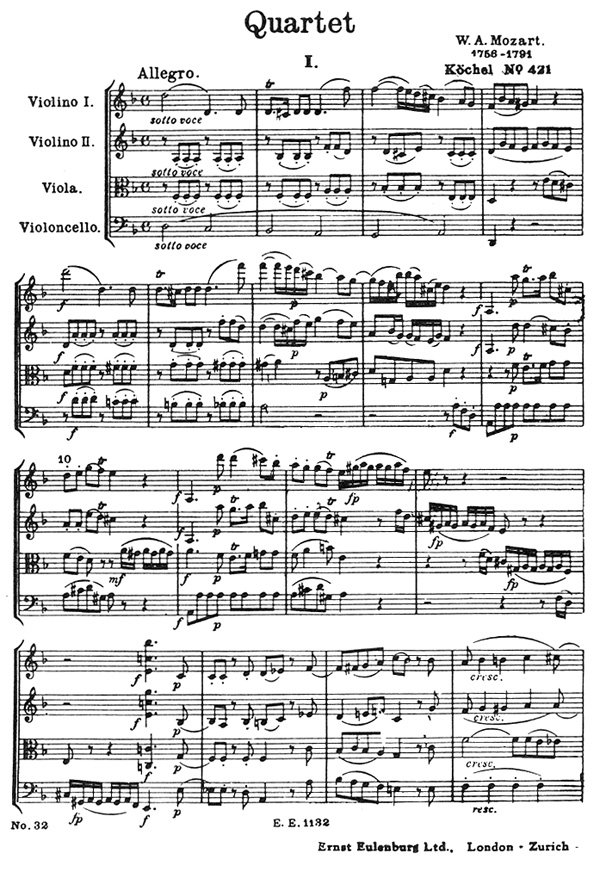
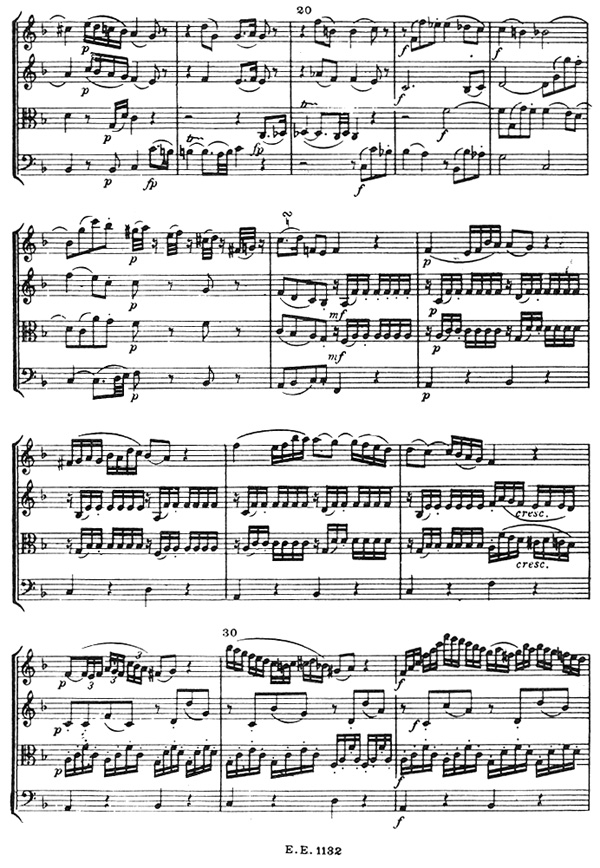
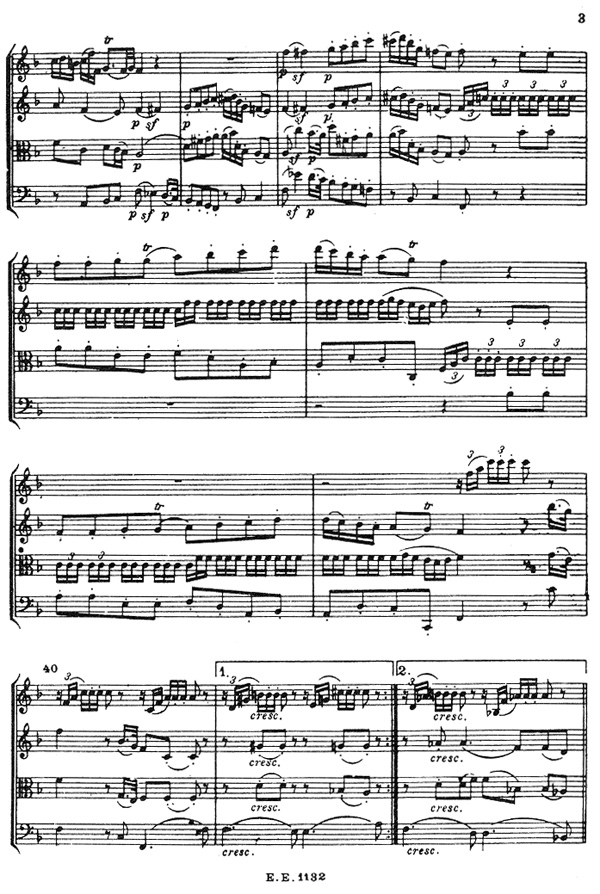
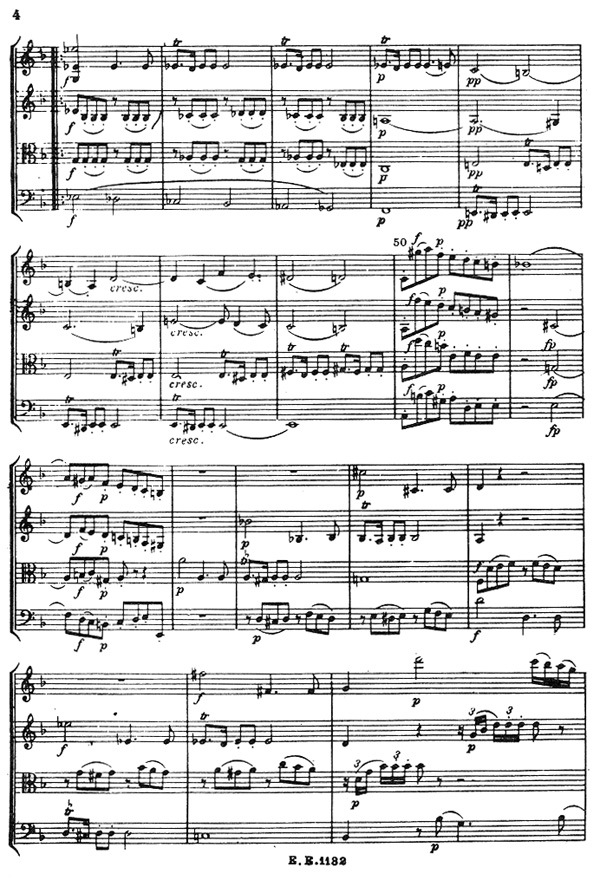
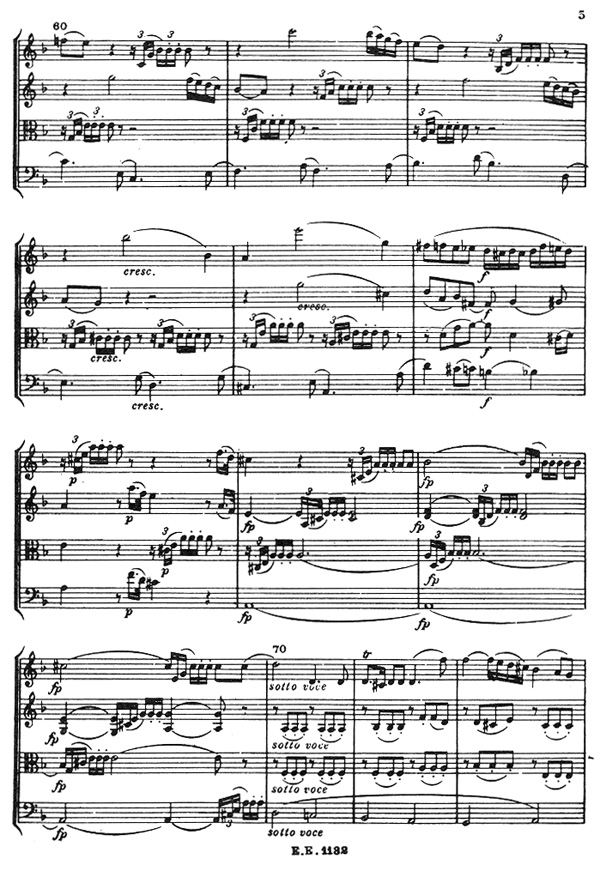
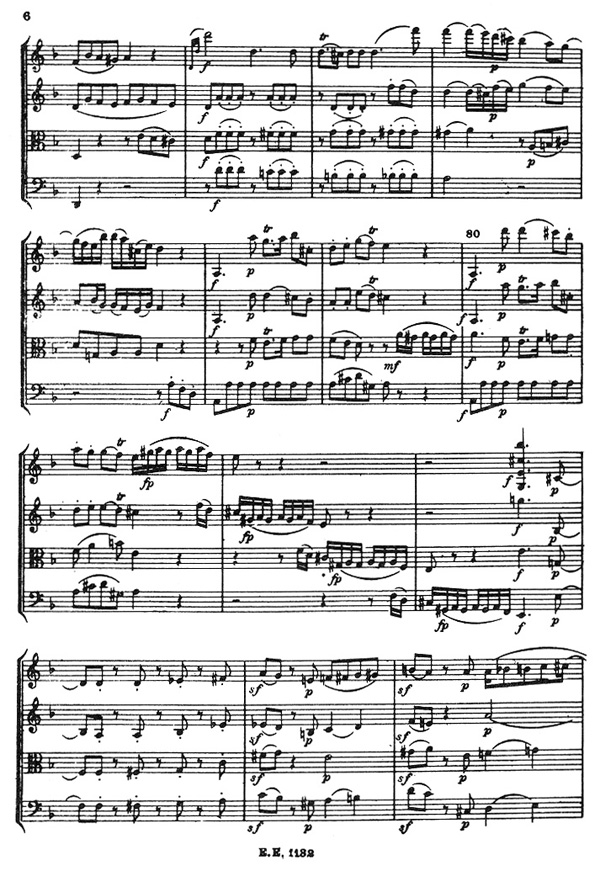
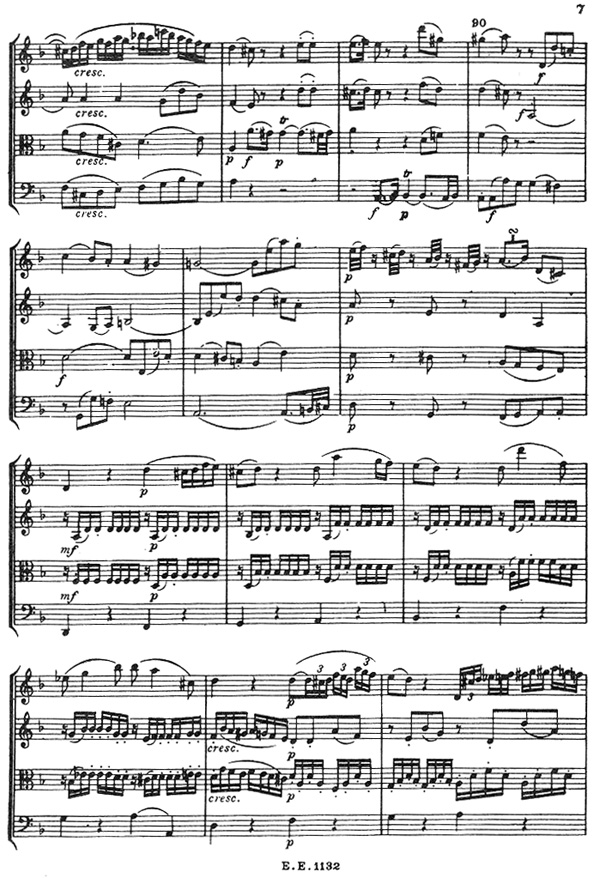
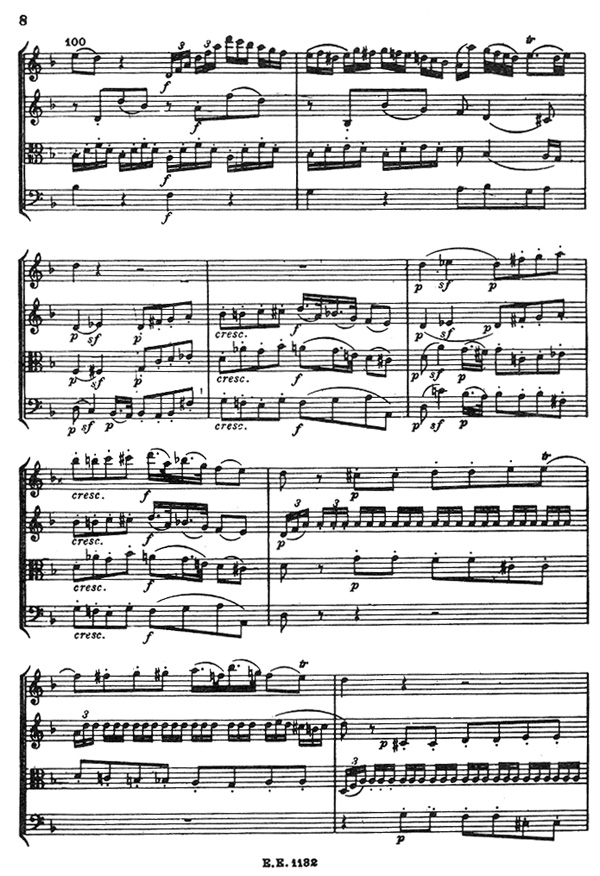
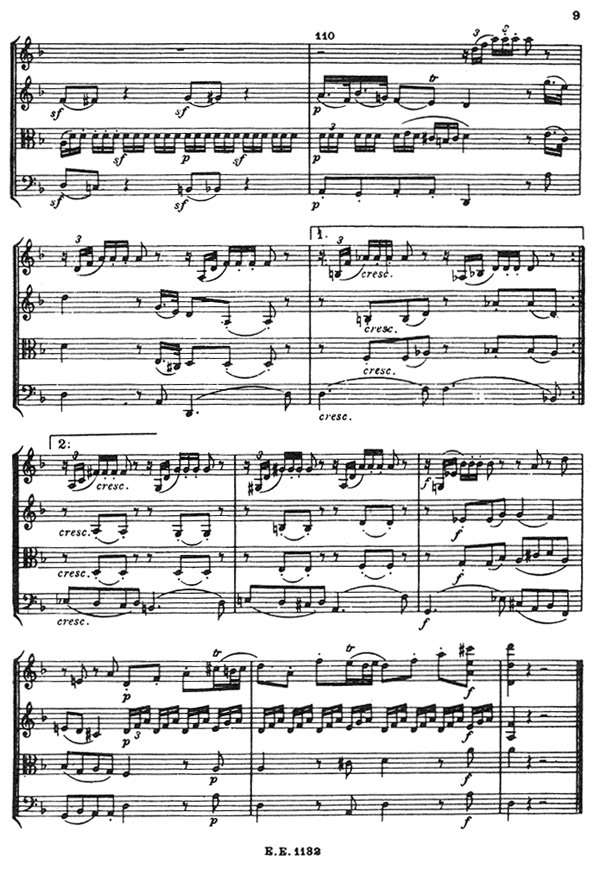
1The concept of interpretation through style analysis presented here owes its origin to the teachings of Jan LaRue, to whom this essay is dedicated with respect and gratitude.
2See Jan LaRue, Guidelines for Style Analysis (New York, 1970), pp. 10-16.
3Cf. Leonard B. Meyer, Explaining Music: Essays and Explorations (Berkeley, 1973), pp. 6-7, 25. Meyer argues for a restrictive definition of style analysis and a clear-cut distinction between style analysis and criticism. Since the tabulation of stylistic norms requires the identification of controlling processes and functions in individual works, it would seem that the two approaches—stylistic and critical—must interpenetrate.
4Heinrich Schenker, "Organic Structure in Sonata Form," trans. Orin Grossman, Journal of Music Theory 12 (1968), 180; reprinted in Readings in Schenker Analysis and Other Approaches, ed. Maury Yeston (New Haven, 1977), pp. 38-53.
5The first movement of K. 421 has proven to be a challenging yet felicitous object of study for theorists and critics. See, for example, I.M. Bruce, "A Note on Mozart's Bar-Rhythms," Music Review 17 (1956), 35-47; Albert Palm, "Mozarts Streichquartett d-moll, KV 421, in der Interpretation Momignys," Mozart-Jahrbuch 1962/63 (Salzburg, 1964), pp. 256-79; William J. Mitchell, "Giuseppe Sarti and Mozart's Quartet, K. 421," Current Musicology 9 (1969), 147-53; John Rothgeb, "Design as a Key to Structure in Tonal Music," Journal of Music Theory 15 (1971), 230-53, reprinted in Readings in Schenker Analysis, pp. 72-93.
6If the cadence in the relative major at m. 40, the establishment of E-flat at m. 42, and the resolution to D minor at m. 70 may be understood as a progression through a minor third, then the figure in the cello, mm. 32 and 34, not only anticipates this progression of pitches but approximates the attendant dynamics (p, sf, p); when the harmonic progression to the Neapolitan occurs in the coda (mm. 113-15), the similarity in dynamics (crescendo to a forte on the E-flat chord, then drop to piano) underscores the relatedness of these events.
7See Meyer, Explaining Music, p. 80.
8See LaRue, Guidelines, p. 115; see also the discussion of rhythmic modules in large and middle dimensions, pp. 106-10. LaRue's concept of relationships between movement and shape in a musical hierarchy corresponds in essential respects to Meyer's distinction between form and process (Explaining Music, p. 90).
9LaRue, Guidelines, pp. 5-9.
10See Bruce, "A Note on Mozart's Bar-Rhythms," pp. 41-42.
11Meyer observes that "when similar events (such as motives . . . ) follow one another in a context of syntactic mobility, they . . . tend to be understood as discrete, though coordinate, events implying a more stable event to which [they] can be related as parts of a larger, integral pattern" ("Grammatical Simplicity and Relational Richness: The Trio of Mozart's G minor Symphony," Critical Inquiry 2 [1976], 718). In the present instance, the four-measure phrase (mm. 42-45) provides a temporarily stabilizing resolution to the preceding succession of half-measure upbeat units, although it too generates open-ended, anacrustic movement as it unfolds.
12The phenomenon described here is comparable to that discussed in connection with mm. 39-41. Here, however, resolution to a relatively stable phrase is deferred until mm. 21-24.
13Acceleration is further enhanced by what may be described as a quickening rate of change in dynamics: in the second phrase (mm. 5-8), the forte level continues for more than two measures before the drop to piano, whereas in mm. 9 and 11, the duration of the forte is shortened to one and a half beats in the upper parts.
14For an interpretation of this passage from a Schenkerian point of view, see Rothgeb, "Design as a Key to Structure in Tonal Music," pp. 244-46 (pp. 85-89 in Readings in Schenker Analysis).
15The concept of melodic gap and fill is developed by Meyer in Explaining Music, pp. 145-57.
16The preliminary resolution in m. 23 plays a significant role by lending harmonic support to the melodic resolution to A2 in the first violin.
17For amplification of this concept of changing and interacting rates of activity, see the discussion of rhythmic layers in LaRue, Guidelines, pp. 90-94.
18LaRue, Guidelines, p. 1.
19See the comment on the "intentional fallacy" in Leo Treitler, "Music Analysis in an Historical Context," College Music Symposium 6 (1966), 80.


